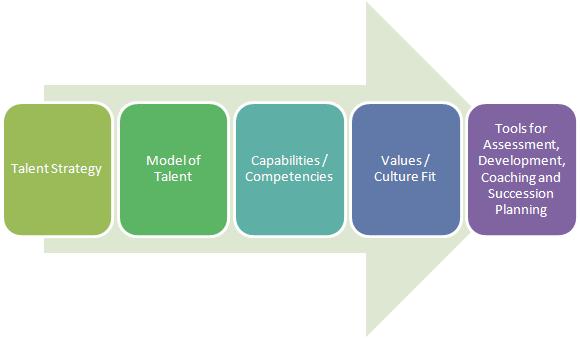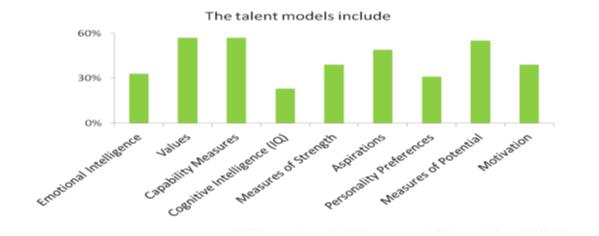Do you have a talent strategy and is it fit for purpose?

Dr Amanda Potter, Katie Bissell and David Nolan discuss the importance of a talent strategy to effectively retain talent within an organisation.
Most organisations accept that Talent is an important element of success. That is, it is important to recruit the right people for the right roles and the company as a whole; and to manage these people effectively in order to retain talent within the organisation.
Despite this, our recent research has identified that as many as 50% of global organisations interviewed do not have a clear definition of talent or a clear talent strategy for the future.1 Rather, they have a number of distinct talent projects and programmes and they roll these programmes out in a robust and valid way. It also found that most organisations have a strong and robust, future facing competency or capability model and have robust assessment and development and succession planning tools. They do not however have a talent strategy to bring this all together.
Over the past 20 years we have seen the growth and demise of the competency model, the growth of capability models, an increase in the use of strength based assessments and a move towards cultural fit and values based assessments. What organisations would benefit from, however, is a clear line of sight from their talent strategy all the way through to the tools they use for assessment, development, retention, coaching and succession planning. The figure below depicts how this might work in practice.

Figure 1: The Link between Talent Strategy and Talent Assessment
In many industries, the need to keep pace with market changes and demands leads organisations to place Talent solutions lower on priority lists, when in fact they should do the opposite, in order to retain good people through difficult and challenging times. This is particularly relevant to Pharma as the pace of change in the life-sciences sector has been relentless. A recent report gathered reflected that around 45,000 job cuts are made a year in Pharma, with the trend peaking in 2010 with 53,636 announced layoffs.2 This, combined with the pressure to demonstrate value based pricing for products, means Talent agendas need to make similar paradigm shifts to the industry. Therefore, Talent models within Pharma need to be placed at the forefront of organisations' mind-sets in order to retain talented individuals though challenging times.
The research questions
At the start of the research, we were interested in finding out:
• Whether organisations have a "talent mind-set" and if they truly see Talent Management as "business critical".
• Whether Talent Strategies are perceived as effective in managing human capital
• If Talent strategies are delivering:
- Differentiation in the market
- Competitive advantage
- Shareholder return and return on investment
- Brand presence and advantage.
• If there are differences in the way those who originate the Talent strategy (HR and Talent Leaders) perceive its success, compared with those who implement it (Business Leaders).
The participating organisations
In order to conduct our research, we interviewed and surveyed 150 senior HR, Talent and Business Leaders from a total of 85 global organisations. These leaders were split as follows:

87% of the organisations were from the Private sector and the rest were from Not for Profit and Public sectors.
"...often organisations have a model of talent and a talent strategy; however there is no clear line of sight between the talent model and individual employee behaviours."
Our findings
The research found that often organisations have a model of talent and a talent strategy; however there is no clear line of sight between the talent model and individual employee behaviours. The graphs below demonstrate this:
Figure 3: research findings
Specifically, we discovered that:
• 32% did not have a talent strategy
• 41% did not understand the talent strategy they had
• 48% did not have a clear definition of talent.
Additionally we found that many organisations' Talent Models are often overly complex and difficult to apply and as a result the users of talent methodologies tend to over simplify it. For example, when we asked the leaders if they have a model of high potential or talent, they often said, "yes we have a nine box." Rather than defining the elements or aspects that underpin talent in their organisation (for example, emotional intelligence, cultural fit, engagement, clear aspirations, drive and motivation). This over simplification of the definition of talent, in many organisations has led to a misinterpretation of the axis of performance and potential on the nine box grid and as a result a mislabelling of people who are talented.
Our top 4 recommendations
As a result of our research and some of the gaps identified in talent practices, we have identified four key recommendations for making Talent Management Strategies a success today.
1. Clearly define talent
One of our key findings was that many organisations do not have a clear definition of talent, or a clear talent strategy. For instance, we found that there are often contradictions within the talent model, for example, very often leaders are encouraged to be authentic and unique, whilst simultaneously living the company norms and values.
"...it is important to ensure that the definitions provided for Talent, give a clear indication of what a Business Leader should be looking for..."
Therefore, it is important to ensure that the definitions provided for Talent, give a clear indication of what a Business Leader should be looking for in Talent and the processes they should use to find these attributes. It should be:
• Scientifically defined, designed and implemented
• Consistent and objective
• Futuristic and applied
• Aligned to all selection and development processes
Therefore, those who design the Talent Model need to consider how it will be used and practically applied within the business. They should frequently evaluate it to ensure it is valid and delivering ROI. This will assist Business Leaders in maximising their Talent resources.
2. Have a clear and focused talent strategy
The ability to grow and develop within an organisation is consistently cited by high performing candidates as a key element in their decision making process when moving between organisations; above salary and features of job design. Therefore, organisations need to ensure they have a talent strategy which allows individuals to grow.
When organisations do not have a talent strategy, they vary widely in their ability to recruit, develop and manage talent. By not having a talent strategy, organisations are less able to nurture and grow talent from within, and therefore are less likely to create a talent mind-set as defined by McKinsey (2001).4 The Leader's ability to manage talent often varies within an organisation or between business areas, this is often due to a lack of clarity, communication and an uncertainty regarding who is responsible for what.
"The failure to balance the tensions between strategy and operations is pervasive... 60% to 80% of companies fall short of success predicted from their new strategies"
Kaplan and Norton 2008, page 64.3
The talent strategy should therefore be fundamental to the delivery of the organisation's long term strategy, and should be at the heart of a Leader's activities. It is important that talent strategy should be implemented strategically and consistently across organisations, with a clear message regarding how it should be utilised. The cohesive execution of the talent strategy is likely to have a positive impact on take-up, buy-in and belief in its value.
"The talent strategy should therefore be fundamental to the delivery of the organisation's long term strategy..."
3. Communicate the talent management strategy across the organisation
We found that very few organisations communicate their talent strategy openly and transparently. Therefore, the employees do not have an understanding of what Talent Management is, or what it means for them. There is a need for a clear line of sight from the originators of Talent Strategy all the way through the organisation to the employee level. Good communication of the Talent Strategy has a marked influence on its success. Communicating the Talent Management Strategy effectively will:
• Increase employee "buy-in"
• Increase employee belief in the value of Talent management
• Demonstrate the organisations support of Talent Management
There are clear benefits to addressing and improving the communication strategy; including:
• Increased motivation
• Increased engagement
• Individual ownership for development
Therefore, it is important to translate the strategy into objectives and measures which can be clearly communicated to all units and employees (Kaplan and Norton, 2008). 3
4. Keep the talent strategy simple
Organisations frequently make talent strategies complex, resulting in a lack of common understanding across and within organisations. Formulating a complex strategy makes it difficult for organisations to translate it into practical goals and targets. There is some confusion regarding what a talent model should include. Our research found the elements depicted in the graph below were considered to be important to a successful talent model:
Figure 4: The talent model
Organisations have a real opportunity to simplify their Talent Management strategies to ensure that leaders understand the "what" and "how" when managing, developing and retaining their talent.
Conclusions
Currently, only 5% of organisations measure the ROI for their Talent Management practices. There will be a future need for organisations to increase their focus on Talent Management in order to remain competitive and drive ROI. In order for a Talent Management strategy to be effective it should be:
• Fundamental to the delivery of the long-term strategy
• At the heart of Leader's activities
• Futuristic and applied
• Transparent and understood
• Consistent, objective and clearly and openly communicated
• Aligned to all selection and development processes
• Scientifically defined, designed and understood
• Proactively planned and applied
• Evaluated to ensure validity, ROI and create shareholder return
References
1. The Future of Talent Management, May 2012. Zircon Management Consulting Published Article. Written by Dr Amanda Potter, Julie Lee, Sarah Linton and Melissa Bentley.
2. Report gathered by the outplacement firm Challenger, Gray & Christmas
3. Kaplan, R.S. & Norton, D.P. (2008). Mastering the Management System. Harvard Business Review. 63-77.
4. McKinsey and Company. (2001). The War for Talent: Organization. and Leadership Practice. McKinsey & Company Inc.
About the authors:
Dr Amanda Potter
Amanda is a Chartered Occupational Psychologist with 19 years experience, she was the founder of Zircon in 2000 and since that time has been splitting her time between running the organisation and working as a consultant for clients. Amanda has international experience working at board level with blue chip clients.
For further details regarding the work that Amanda, and Zircon Management Consulting, do please visit our website: www.zircon-mc.co.uk
Katie Bissell
Katie has recently joined Zircon, following the completion of her Msc in Occupational Psychology, from which she graduated with an academic excellence award. Katie is currently enjoying being able to apply her acquired knowledge, and is energized by the opportunity to gain practical experience in all areas of occupational psychology. Since becoming a part of the Zircon team, Katie has quickly taken on varying client, and research projects, and has been assessing at graduate and manager levels.
David Nolan
David ensures that the Talentmark solutions focused approach is 'best in class' and delivers optimum value for Talentmark clients globally. He seeks continually for new ways to add value through an innovative product/service mix.
David directs the Consulting team's activities for the business, in addition to delivering strategic senior search assignments for key clients.
Does your organisation measure the ROI for its Talent Management practices?














